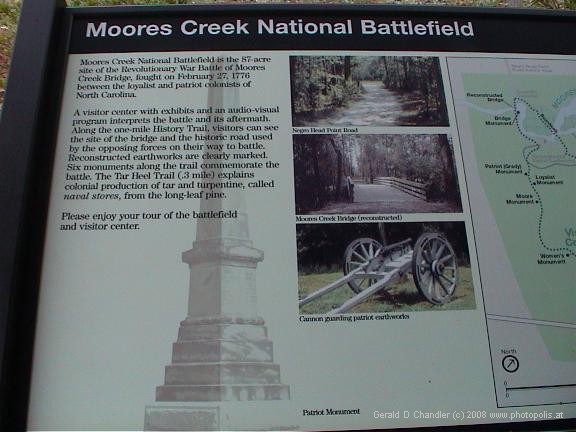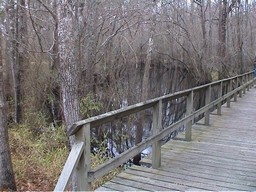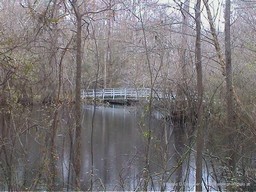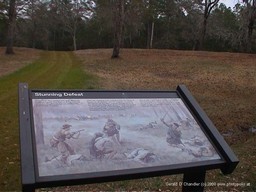Home | Front Page | Index | Blog | New | Contact | Site Map
Smithfield | Moores Creek | Photos

Virginia
North Carolina
South Carolina
Georgia
Florida
Alabama
Mississippi
Louisiana
Texas
Arizona
California
Nevada
Index 1999-2002
Index 2003-2004
Index 2005-2006
Index 2007-2008
Index 2009-2011

Moore's Creek Battlefield Sign |
We had tried to visit Moore's Creek Battlefield on our previous visit to the south, but had arrived at the gate just at closin. This time Gerry was determined to see it and so squeezed it in on our drive down from Virginia to South Carolina to see the Eddy's

Swamp Walk |

Swamp Walk |
It is small, as such places go, only 30-60 acres and little visited. It is not on any major path to any major place. Too bad for others, but great for us.
Moore’s Creek was the site of a battle in February, 1776 between American revolutionaries (on the one hand) and a coalition of Loyalist Americans and British troops. The Revolutionaries defeated the British coalition (including Scottish Highlanders, who made their last broadsword charge at this site) and greatly influenced North Carolina politics so that the people became solidly in the Revolutionary camp.

Park |

Park |

Canon |
We walked the nicely signed battlefield trail and learned how the Scottish Highlanders had been duped into thinking that enemy forces were camped on one side of the creek, only to find the next morning that they had quietly decamped in the night and removed the crossplanks from the bridge across the creek. The Scots nonethless valiantly made their broadsword charge across the skeleton of the bridge only to find that it had been greased. They were decimated by the revolutionary troops waiting on the other side of the creek.
After walking the mile plus battle trail we took the 1/3 mile Turpentine trail where we learned about naval stores, turpentine, tar, and pitch. To our surprise, the first, “naval stores” consists of the latter three. In 1700-1800 British shipping and thus British world power was supported by a ready, secure supply of these materials, largely from North Carolina. They contibuted mightly to the development and riches of North Carolina and perhaps explain why at the outset of the Revolutionary War most North Carolinians were loyal to the Crown.

Tree around Tree |